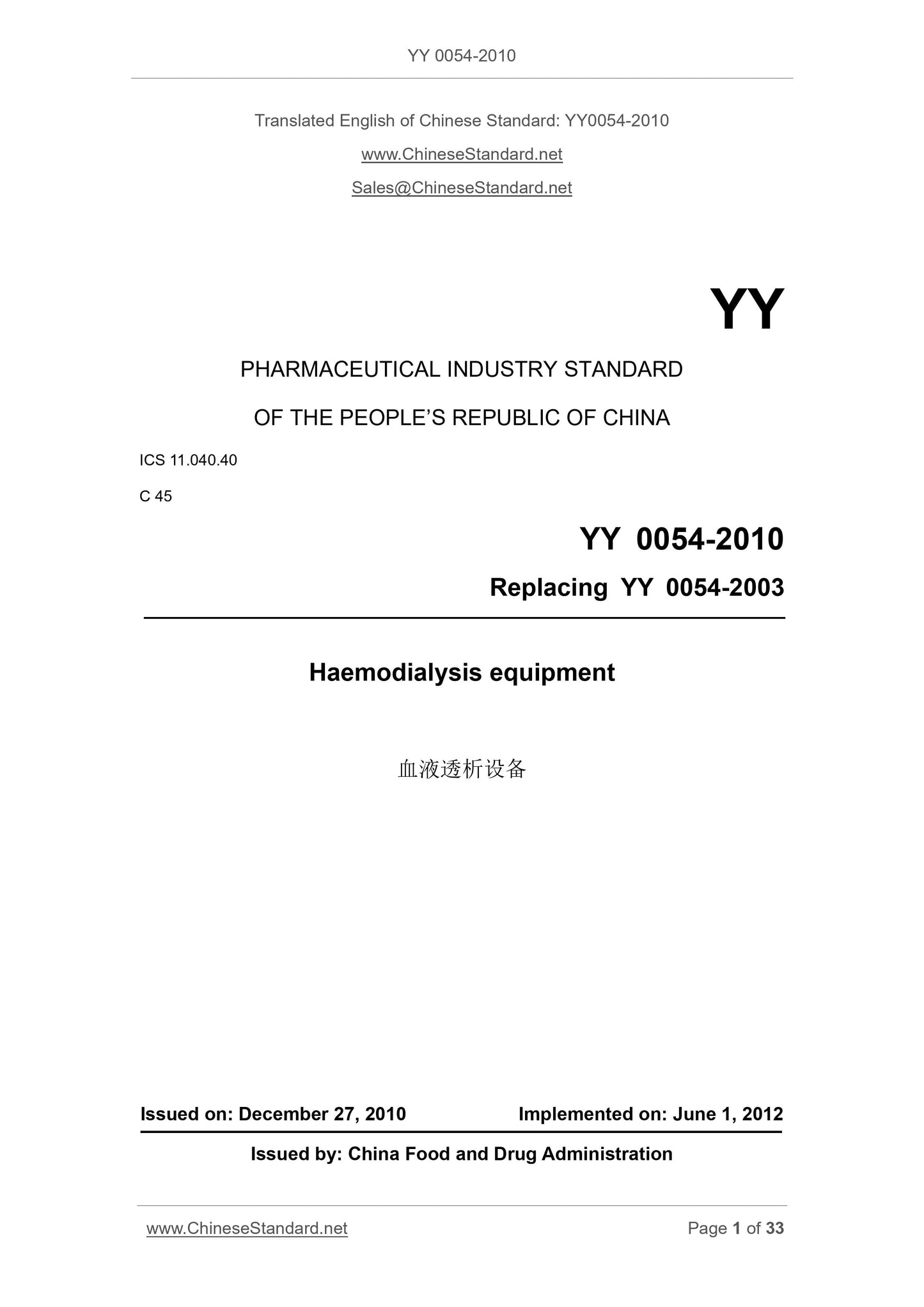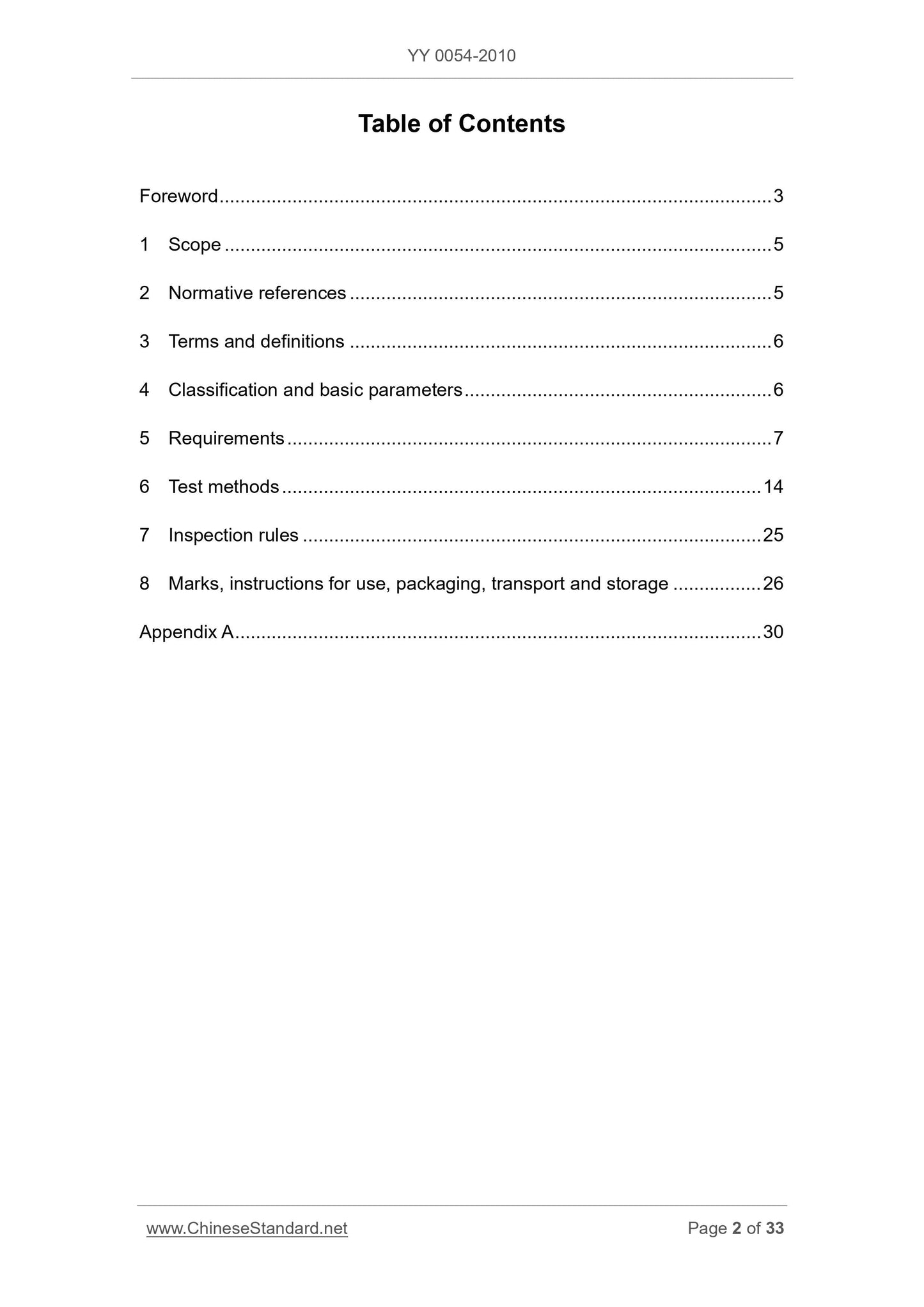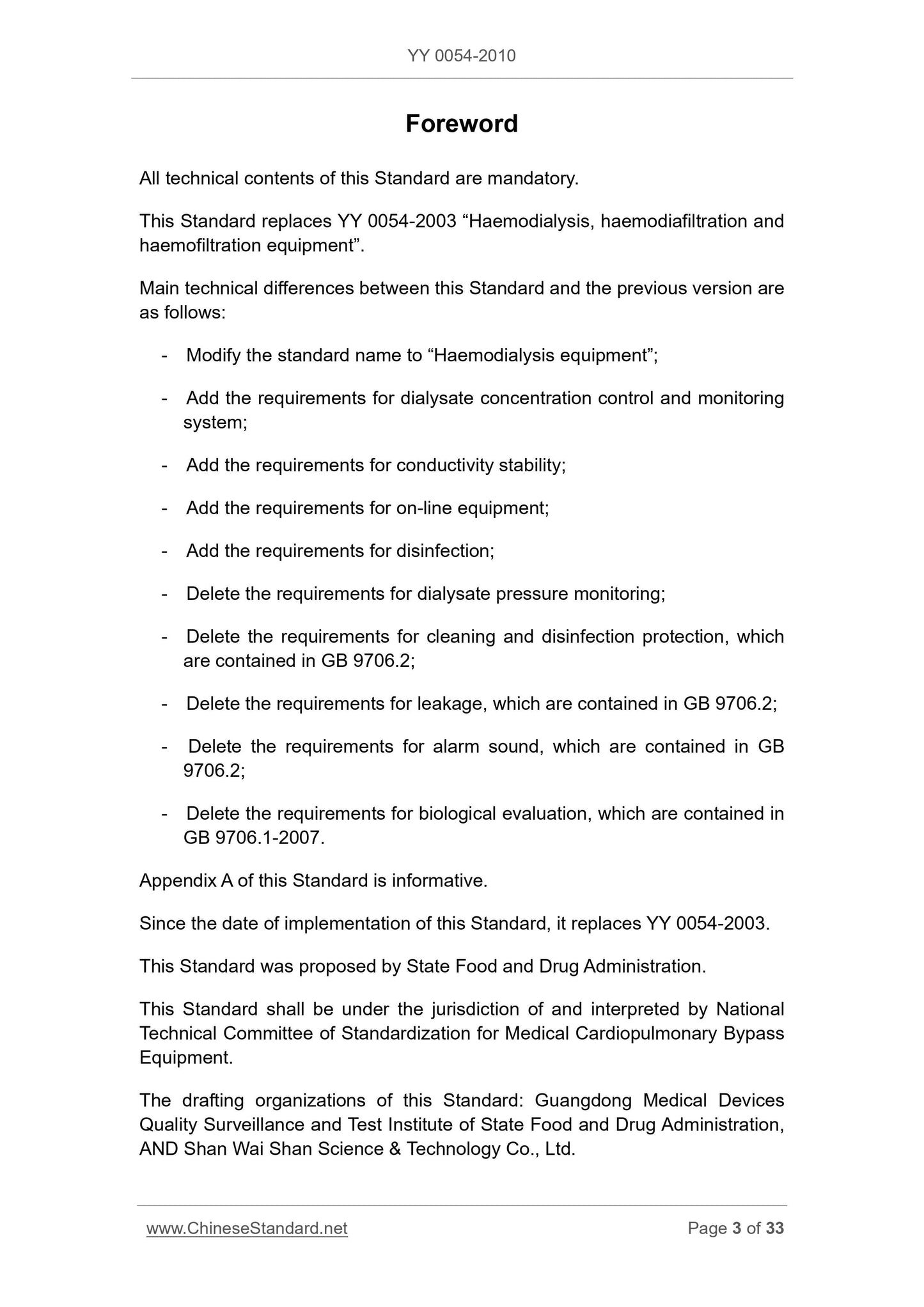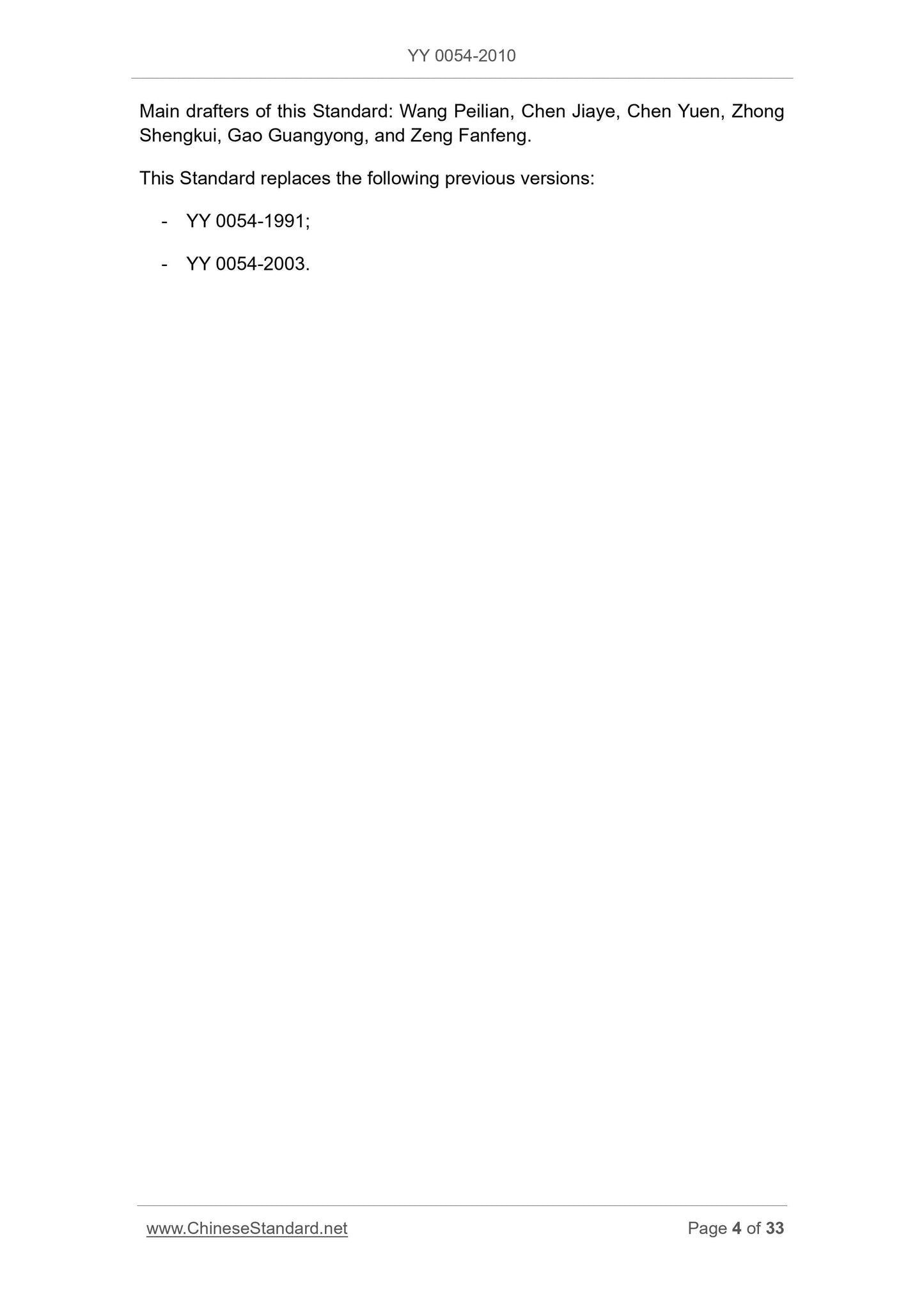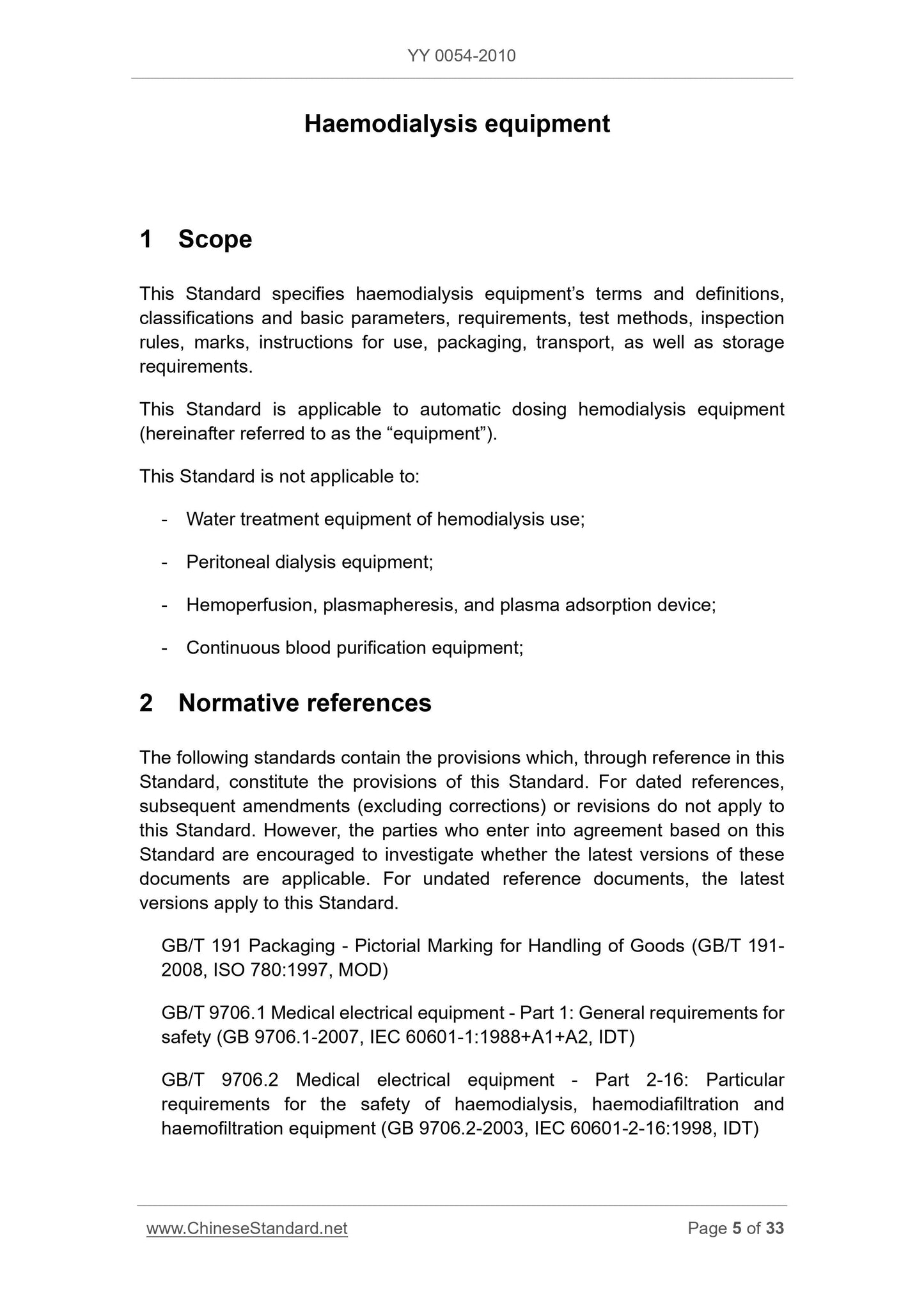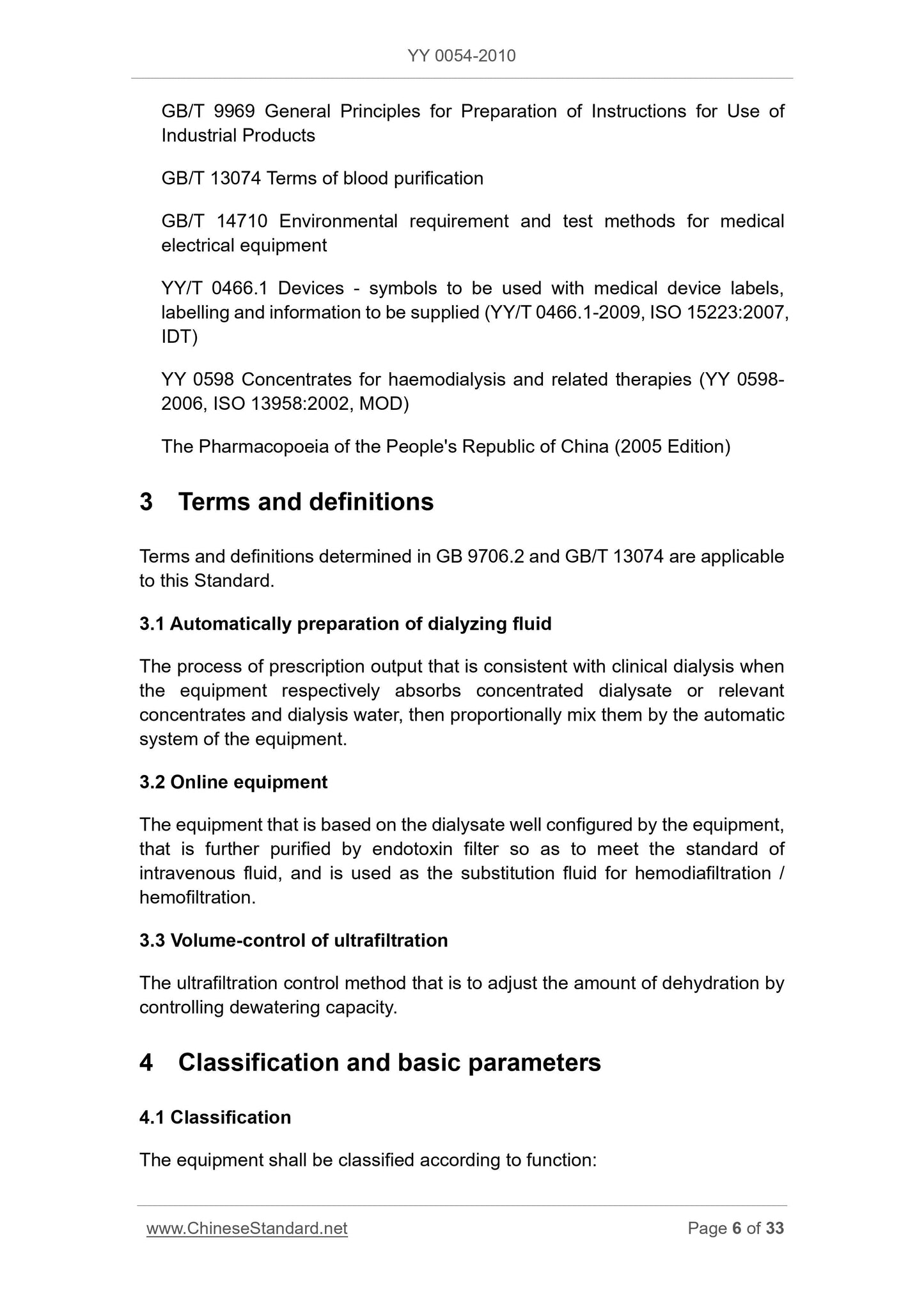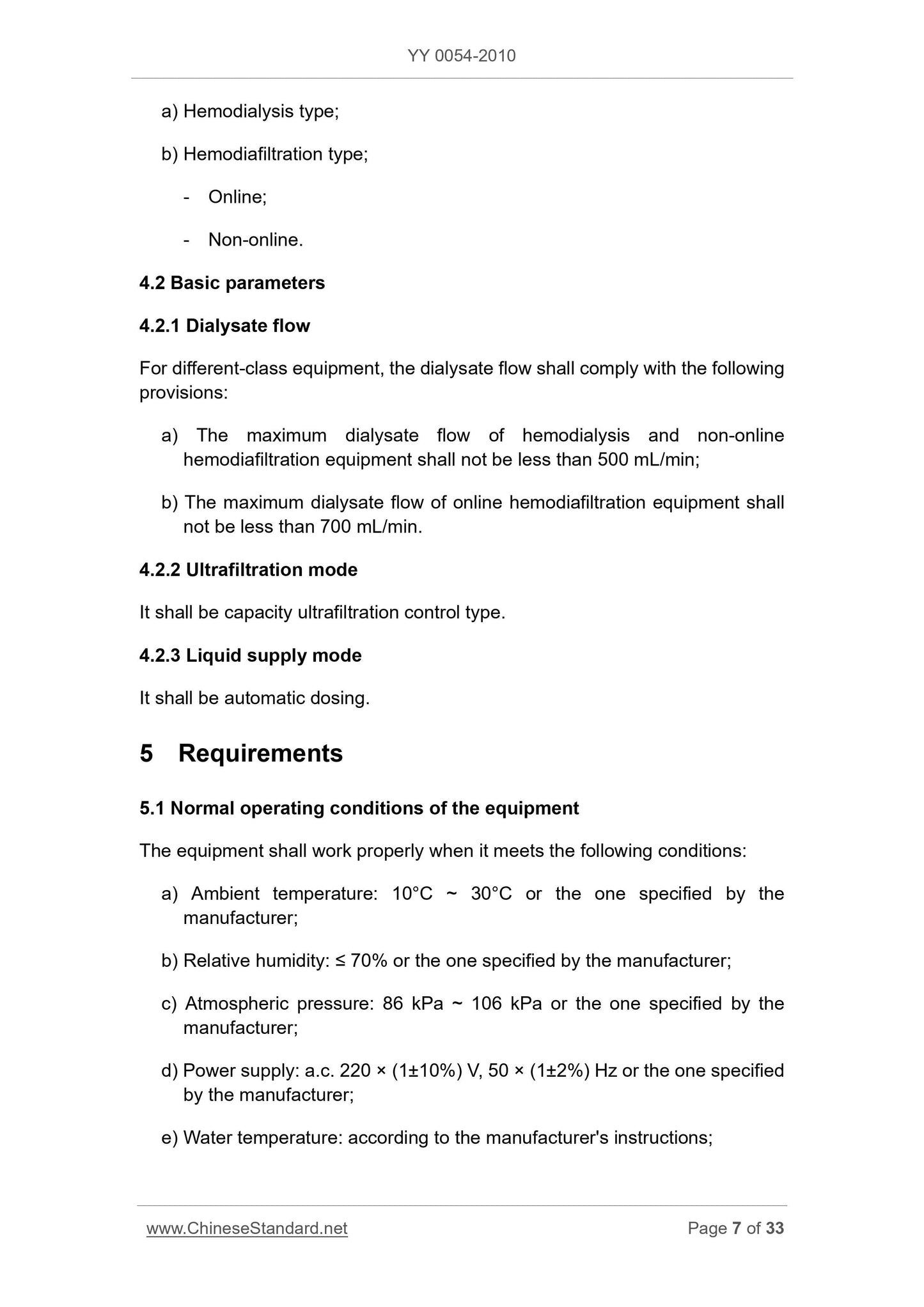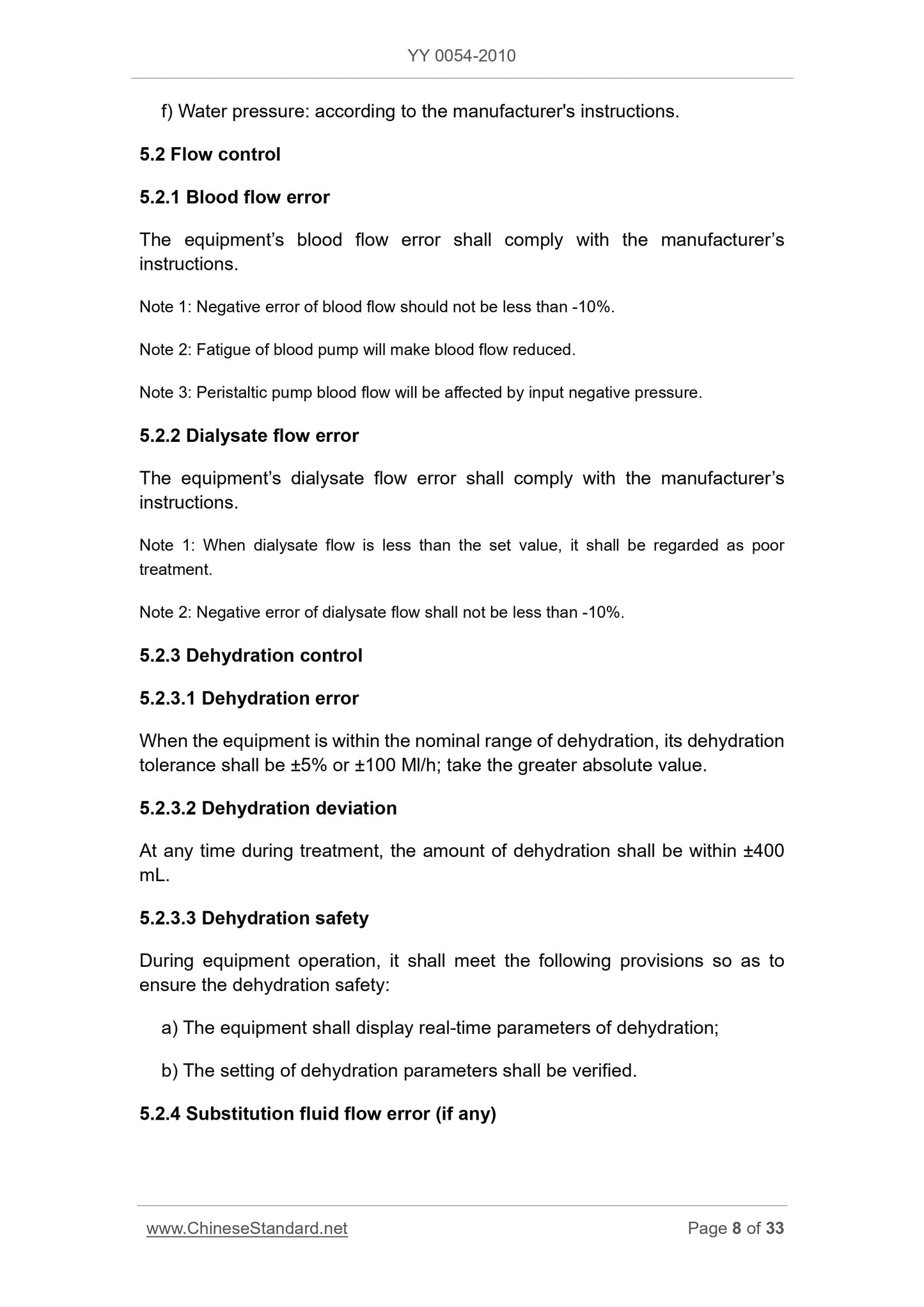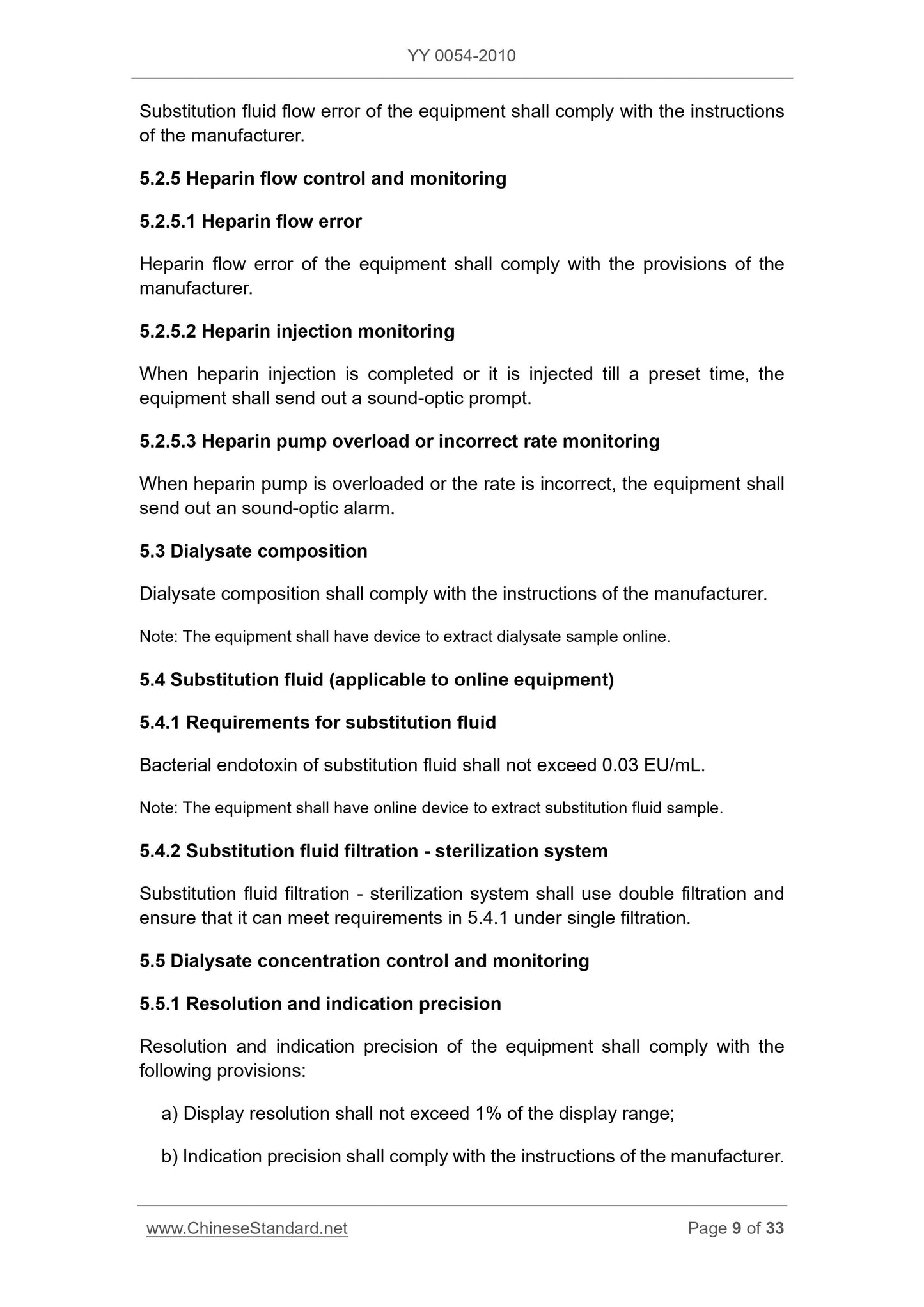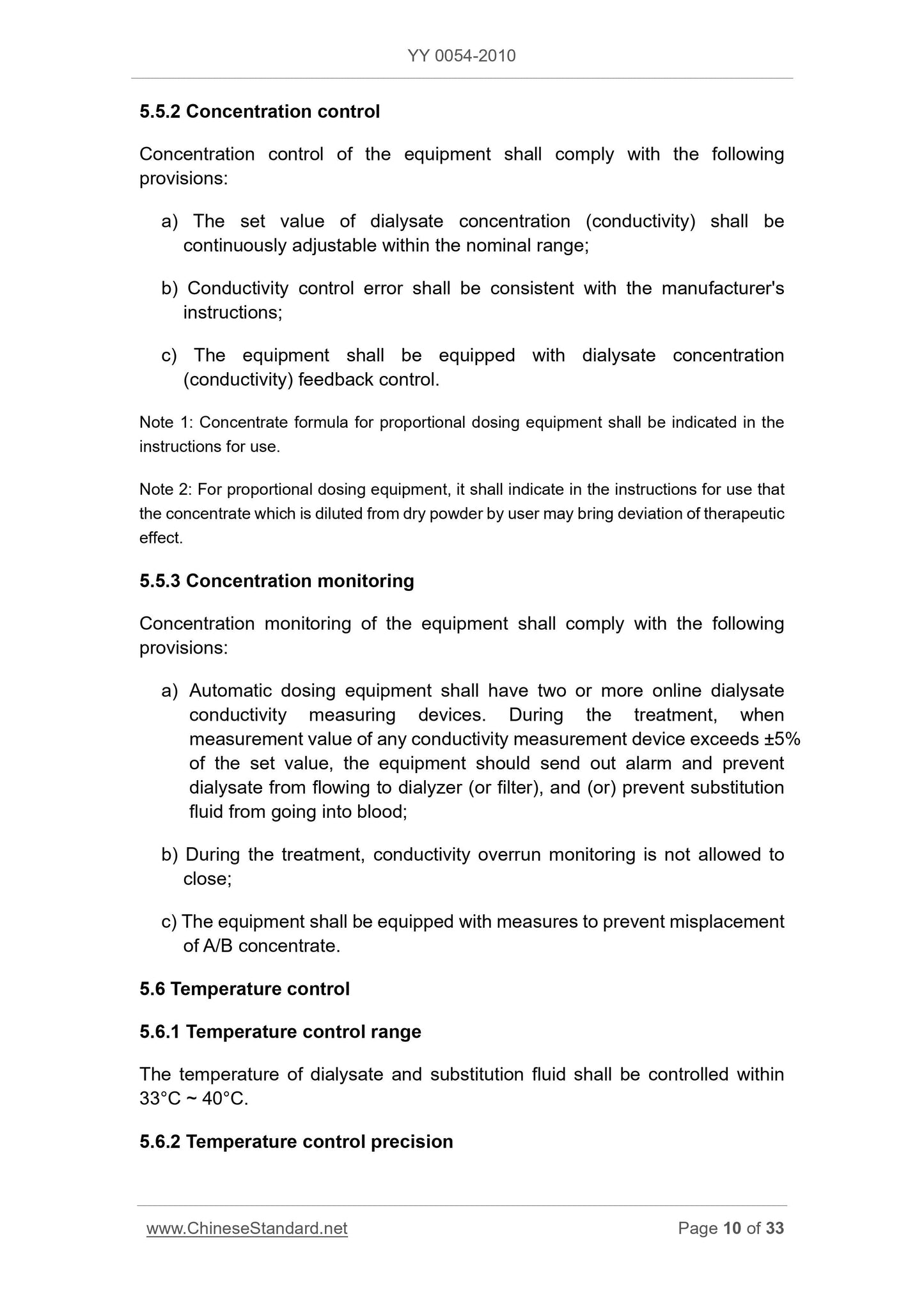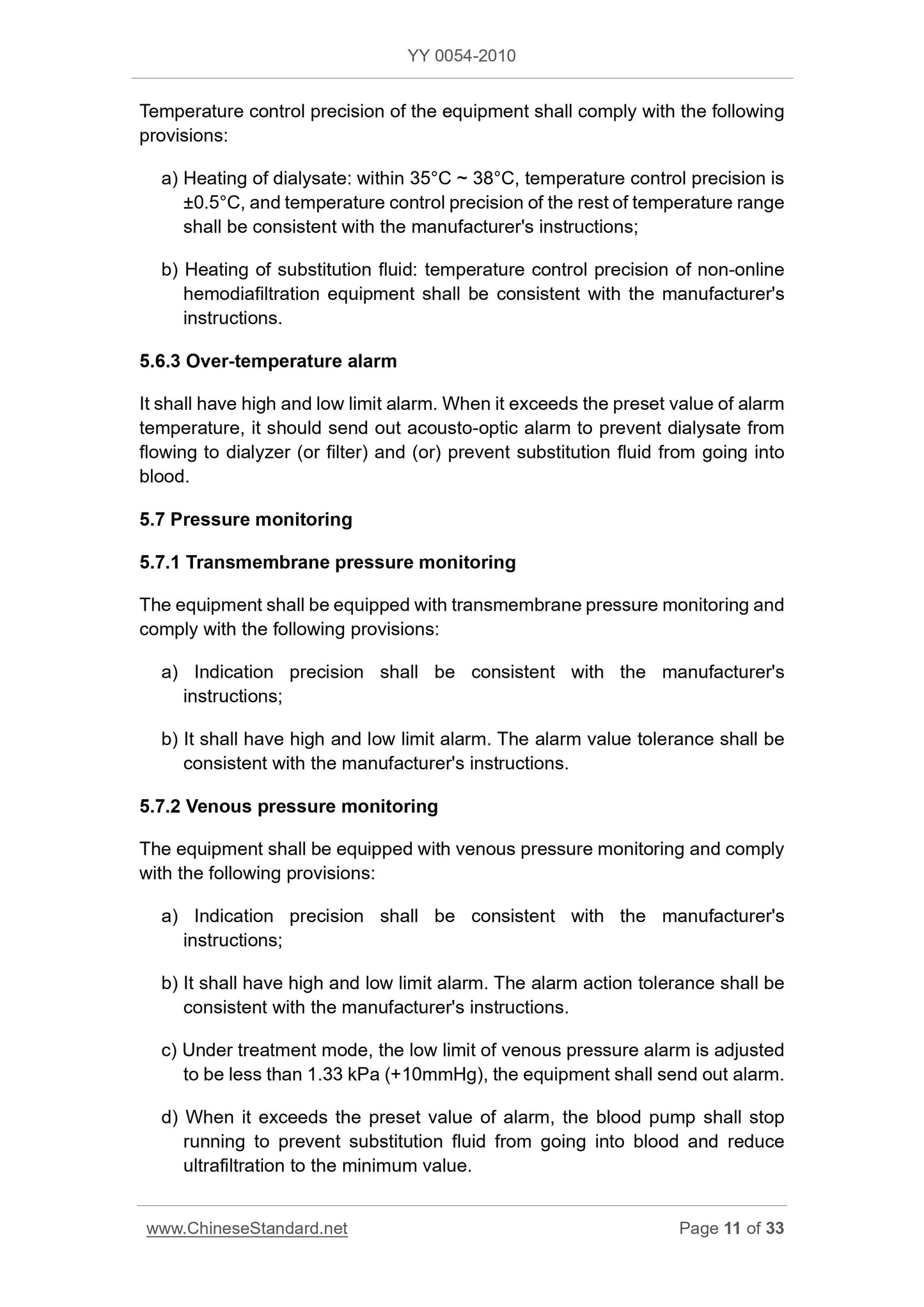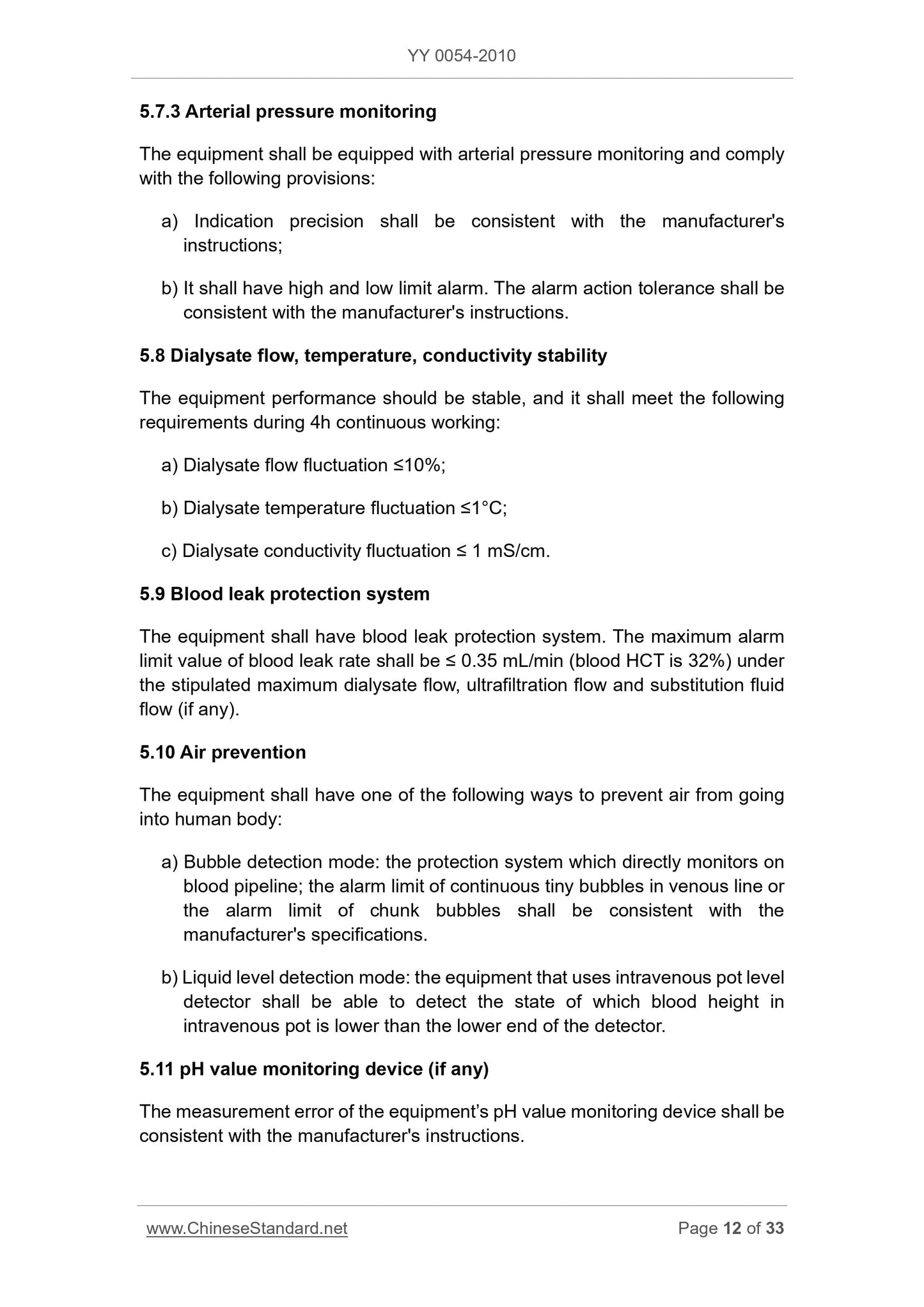1
/
of
12
PayPal, credit cards. Download editable-PDF & invoice in 1 second!
YY 0054-2010 English PDF
YY 0054-2010 English PDF
Regular price
$145.00
Regular price
Sale price
$145.00
Unit price
/
per
Shipping calculated at checkout.
Couldn't load pickup availability
YY 0054-2010: Haemodialysis equipment
Delivery: 9 seconds. Download (and Email) true-PDF + Invoice.
Newer version: (Replacing this standard) YY 0054-2023
Get Quotation: Click YY 0054-2010 (Self-service in 1-minute)
Historical versions (Master-website): YY 0054-2023
Preview True-PDF (Reload/Scroll-down if blank)
YY 0054-2010
YY
PHARMACEUTICAL INDUSTRY STANDARD
OF THE PEOPLE’S REPUBLIC OF CHINA
ICS 11.040.40
C 45
Replacing YY 0054-2003
Haemodialysis equipment
血液透析设备
ISSUED ON. DECEMBER 27, 2010
IMPLEMENTED ON. JUNE 1, 2012
Issued by. China Food and Drug Administration
Table of Contents
Foreword ... 3
1 Scope ... 5
2 Normative references ... 5
3 Terms and definitions ... 6
4 Classification and basic parameters ... 6
5 Requirements ... 7
6 Test methods ... 14
7 Inspection rules ... 25
8 Marks, instructions for use, packaging, transport and storage ... 26
Appendix A ... 30
Foreword
All technical contents of this Standard are mandatory.
This Standard replaces YY 0054-2003 “Haemodialysis, haemodiafiltration and
haemofiltration equipment”.
Main technical differences between this Standard and the previous version are
as follows.
- Modify the standard name to “Haemodialysis equipment”;
- Add the requirements for dialysate concentration control and monitoring
system;
- Add the requirements for conductivity stability;
- Add the requirements for on-line equipment;
- Add the requirements for disinfection;
- Delete the requirements for dialysate pressure monitoring;
- Delete the requirements for cleaning and disinfection protection, which
are contained in GB 9706.2;
- Delete the requirements for leakage, which are contained in GB 9706.2;
- Delete the requirements for alarm sound, which are contained in GB
9706.2;
- Delete the requirements for biological evaluation, which are contained in
GB 9706.1-2007.
Appendix A of this Standard is informative.
Since the date of implementation of this Standard, it replaces YY 0054-2003.
This Standard was proposed by State Food and Drug Administration.
This Standard shall be under the jurisdiction of and interpreted by National
Technical Committee of Standardization for Medical Cardiopulmonary Bypass
Equipment.
The drafting organizations of this Standard. Guangdong Medical Devices
Quality Surveillance and Test Institute of State Food and Drug Administration,
AND Shan Wai Shan Science and Technology Co., Ltd.
Main drafters of this Standard. Wang Peilian, Chen Jiaye, Chen Yuen, Zhong
Shengkui, Gao Guangyong, and Zeng Fanfeng.
This Standard replaces the following previous versions.
- YY 0054-1991;
- YY 0054-2003.
Haemodialysis equipment
1 Scope
This Standard specifies haemodialysis equipment’s terms and definitions,
classifications and basic parameters, requirements, test methods, inspection
rules, marks, instructions for use, packaging, transport, as well as storage
requirements.
This Standard is applicable to automatic dosing hemodialysis equipment
(hereinafter referred to as the “equipment”).
This Standard is not applicable to.
- Water treatment equipment of hemodialysis use;
- Peritoneal dialysis equipment;
- Hemoperfusion, plasmapheresis, and plasma adsorption device;
- Continuous blood purification equipment;
2 Normative references
The following standards contain the provisions which, through reference in this
Standard, constitute the provisions of this Standard. For dated references,
subsequent amendments (excluding corrections) or revisions do not apply to
this Standard. However, the parties who enter into agreement based on this
Standard are encouraged to investigate whether the latest versions of these
documents are applicable. For undated reference documents, the latest
versions apply to this Standard.
GB/T 191 Packaging - Pictorial Marking for Handling of Goods (GB/T 191-
2008, ISO 780.1997, MOD)
GB/T 9706.1 Medical electrical equipment - Part 1. General requirements for
safety (GB 9706.1-2007, IEC 60601-1.1988+A1+A2, IDT)
GB/T 9706.2 Medical electrical equipment - Part 2-16. Particular
requirements for the safety of haemodialysis, haemodiafiltration and
haemofiltration equipment (GB 9706.2-2003, IEC 60601-2-16.1998, IDT)
GB/T 9969 General Principles for Preparation of Instructions for Use of
Industrial Products
GB/T 13074 Terms of blood purification
GB/T 14710 Environmental requirement and test methods for medical
electrical equipment
YY/T 0466.1 Devices - symbols to be used with medical device labels,
labelling and information to be supplied (YY/T 0466.1-2009, ISO 15223.2007,
IDT)
YY 0598 Concentrates for haemodialysis and related therapies (YY 0598-
2006, ISO 13958.2002, MOD)
The Pharmacopoeia of the People's Republic of China (2005 Edition)
3 Terms and definitions
Terms and definitions determined in GB 9706.2 and GB/T 13074 are applicable
to this Standard.
3.1 Automatically preparation of dialyzing fluid
The process of prescription output that is consistent with clinical dialysis when
the equipment respectively absorbs concentrated dialysate or relevant
concentrates and dialysis water, then proportionally mix them by the automatic
system of the equipment.
3.2 Online equipment
The equipment that is based on the dialysate well configured by the equipment,
that is further purified by endotoxin filter so as to meet the standard of
intravenous fluid, and is used as the substitution fluid for hemodiafiltration /
hemofiltration.
3.3 Volume-control of ultrafiltration
The ultrafiltration control method that is to adjust the amount of dehydration by
controlling dewatering capacity.
4 Classification and basic parameters
4.1 Classification
The equipment shall be classified according to function.
a) Hemodialysis type;
b) Hemodiafiltration type;
- Online;
- Non-online.
4.2 Basic parameters
4.2.1 Dialysate flow
For different-class equipment, the dialysate flow shall comply with the following
provisions.
a) The maximum dialysate flow of hemodialysis and non-online
hemodiafiltration equipment shall not be less than 500 mL/min;
b) The maximum dialysate flow of online hemodiafiltration equipment shall
not be less than 700 mL/min.
4.2.2 Ultrafiltration mode
It shall be capacity ultrafiltration control type.
4.2.3 Liquid supply mode
It shall be automatic dosing.
5 Requirements
5.1 Normal operating conditions of the equipment
The equipment shall work properly when it meets the following conditions.
a) Ambient temperature. 10°C ~ 30°C or the one specified by the
manufacturer;
b) Relative humidity. ≤ 70% or the one specified by the manufacturer;
c) Atmospheric pressure. 86 kPa ~ 106 kPa or the one specified by the
manufacturer;
d) Power supply. a.c. 220 × (1±10%) V, 50 × (1±2%) Hz or the one specified
by the manufacturer;
e) Water temperature. according to the manufacturer's instructions;
f) Water pressure. according to the manufacturer's instructions.
5.2 Flow control
5.2.1 Blood flow error
The equipment’s blood flow error shall comply with the manufacturer’s
instructions.
Note 1. Negative error of blood flow should not be less than -10%.
Note 2. Fatigue of blood pump will make blood flow reduced.
Note 3. Peristaltic pump blood flow will be affected by input negative pressure.
5.2.2 Dialysate flow error
The equipment’s dialysate flow error shall comply with the manufacturer’s
instructions.
Note 1. When dialysate flow is less than the set value, it shall be regarded as poor
treatment.
Note 2. Negative error of dialysate flow shall not be less than -10%.
5.2.3 Dehydration control
5.2.3.1 Dehydration error
When the equipment is within the nominal range of dehydration, its dehydration
tolerance shall be ±5% or ±100 Ml/h; take the greater absolute value.
5.2.3.2 Dehydration deviation
At any time during treatment, the amount of dehydration shall be within ±400
mL.
5.2.3.3 Dehydration safety
During equipment operation, it shall meet the following provisions so as to
ensure the dehydration safety.
a) The equipment shall display real-time parameters of dehydration;
b) The setting of dehydration parameters shall be verified.
5.2.4 Substitution fluid flow error (if any)
Substitution fluid flow error of the equipment shall comply with the instructions
of the manufacturer.
5.2.5 Heparin flow control and monitoring
5.2.5.1 Heparin flow error
Heparin flow error of the equipment shall comply with the provisions of the
manufacturer.
5.2.5.2 Heparin injection monitoring
When heparin injection is completed or it is injected till a preset time, the
equipment shall send out a sound-optic prompt.
5.2.5.3 Heparin pump overload or incorrect rate monitoring
When heparin pump is overloaded or the rate is incorrect, the equipment shall
send out an sound-optic alarm.
5.3 Dialysate composition
Dialysate composition shall comply with the instructions of the manufacturer.
Note. The equipment shall have device to extract dialysate sample online.
5.4 Substitution fluid (applicable to online equipment)
5.4.1 Requirements for substitution fluid
Bacterial endotoxin of substitution fluid shall not exceed 0.03 EU/mL.
Note. The equipment shall have online device to extract substitution fluid sample.
5.4.2 Substitution fluid filtration - sterilization system
Substitution fluid filtration - ster...
YY 0054-2010
YY
PHARMACEUTICAL INDUSTRY STANDARD
OF THE PEOPLE’S REPUBLIC OF CHINA
ICS 11.040.40
C 45
Replacing YY 0054-2003
Haemodialysis equipment
血液透析设备
ISSUED ON. DECEMBER 27, 2010
IMPLEMENTED ON. JUNE 1, 2012
Issued by. China Food and Drug Administration
Table of Contents
Foreword ... 3
1 Scope ... 5
2 Normative references ... 5
3 Terms and definitions ... 6
4 Classification and basic parameters ... 6
5 Requirements ... 7
6 Test methods ... 14
7 Inspection rules ... 25
8 Marks, instructions for use, packaging, transport and storage ... 26
Appendix A ... 30
Foreword
All technical contents of this Standard are mandatory.
This Standard replaces YY 0054-2003 “Haemodialysis, haemodiafiltration and
haemofiltration equipment”.
Main technical differences between this Standard and the previous version are
as follows.
- Modify the standard name to “Haemodialysis equipment”;
- Add the requirements for dialysate concentration control and monitoring
system;
- Add the requirements for conductivity stability;
- Add the requirements for on-line equipment;
- Add the requirements for disinfection;
- Delete the requirements for dialysate pressure monitoring;
- Delete the requirements for cleaning and disinfection protection, which
are contained in GB 9706.2;
- Delete the requirements for leakage, which are contained in GB 9706.2;
- Delete the requirements for alarm sound, which are contained in GB
9706.2;
- Delete the requirements for biological evaluation, which are contained in
GB 9706.1-2007.
Appendix A of this Standard is informative.
Since the date of implementation of this Standard, it replaces YY 0054-2003.
This Standard was proposed by State Food and Drug Administration.
This Standard shall be under the jurisdiction of and interpreted by National
Technical Committee of Standardization for Medical Cardiopulmonary Bypass
Equipment.
The drafting organizations of this Standard. Guangdong Medical Devices
Quality Surveillance and Test Institute of State Food and Drug Administration,
AND Shan Wai Shan Science and Technology Co., Ltd.
Main drafters of this Standard. Wang Peilian, Chen Jiaye, Chen Yuen, Zhong
Shengkui, Gao Guangyong, and Zeng Fanfeng.
This Standard replaces the following previous versions.
- YY 0054-1991;
- YY 0054-2003.
Haemodialysis equipment
1 Scope
This Standard specifies haemodialysis equipment’s terms and definitions,
classifications and basic parameters, requirements, test methods, inspection
rules, marks, instructions for use, packaging, transport, as well as storage
requirements.
This Standard is applicable to automatic dosing hemodialysis equipment
(hereinafter referred to as the “equipment”).
This Standard is not applicable to.
- Water treatment equipment of hemodialysis use;
- Peritoneal dialysis equipment;
- Hemoperfusion, plasmapheresis, and plasma adsorption device;
- Continuous blood purification equipment;
2 Normative references
The following standards contain the provisions which, through reference in this
Standard, constitute the provisions of this Standard. For dated references,
subsequent amendments (excluding corrections) or revisions do not apply to
this Standard. However, the parties who enter into agreement based on this
Standard are encouraged to investigate whether the latest versions of these
documents are applicable. For undated reference documents, the latest
versions apply to this Standard.
GB/T 191 Packaging - Pictorial Marking for Handling of Goods (GB/T 191-
2008, ISO 780.1997, MOD)
GB/T 9706.1 Medical electrical equipment - Part 1. General requirements for
safety (GB 9706.1-2007, IEC 60601-1.1988+A1+A2, IDT)
GB/T 9706.2 Medical electrical equipment - Part 2-16. Particular
requirements for the safety of haemodialysis, haemodiafiltration and
haemofiltration equipment (GB 9706.2-2003, IEC 60601-2-16.1998, IDT)
GB/T 9969 General Principles for Preparation of Instructions for Use of
Industrial Products
GB/T 13074 Terms of blood purification
GB/T 14710 Environmental requirement and test methods for medical
electrical equipment
YY/T 0466.1 Devices - symbols to be used with medical device labels,
labelling and information to be supplied (YY/T 0466.1-2009, ISO 15223.2007,
IDT)
YY 0598 Concentrates for haemodialysis and related therapies (YY 0598-
2006, ISO 13958.2002, MOD)
The Pharmacopoeia of the People's Republic of China (2005 Edition)
3 Terms and definitions
Terms and definitions determined in GB 9706.2 and GB/T 13074 are applicable
to this Standard.
3.1 Automatically preparation of dialyzing fluid
The process of prescription output that is consistent with clinical dialysis when
the equipment respectively absorbs concentrated dialysate or relevant
concentrates and dialysis wa...
Delivery: 9 seconds. Download (and Email) true-PDF + Invoice.
Newer version: (Replacing this standard) YY 0054-2023
Get Quotation: Click YY 0054-2010 (Self-service in 1-minute)
Historical versions (Master-website): YY 0054-2023
Preview True-PDF (Reload/Scroll-down if blank)
YY 0054-2010
YY
PHARMACEUTICAL INDUSTRY STANDARD
OF THE PEOPLE’S REPUBLIC OF CHINA
ICS 11.040.40
C 45
Replacing YY 0054-2003
Haemodialysis equipment
血液透析设备
ISSUED ON. DECEMBER 27, 2010
IMPLEMENTED ON. JUNE 1, 2012
Issued by. China Food and Drug Administration
Table of Contents
Foreword ... 3
1 Scope ... 5
2 Normative references ... 5
3 Terms and definitions ... 6
4 Classification and basic parameters ... 6
5 Requirements ... 7
6 Test methods ... 14
7 Inspection rules ... 25
8 Marks, instructions for use, packaging, transport and storage ... 26
Appendix A ... 30
Foreword
All technical contents of this Standard are mandatory.
This Standard replaces YY 0054-2003 “Haemodialysis, haemodiafiltration and
haemofiltration equipment”.
Main technical differences between this Standard and the previous version are
as follows.
- Modify the standard name to “Haemodialysis equipment”;
- Add the requirements for dialysate concentration control and monitoring
system;
- Add the requirements for conductivity stability;
- Add the requirements for on-line equipment;
- Add the requirements for disinfection;
- Delete the requirements for dialysate pressure monitoring;
- Delete the requirements for cleaning and disinfection protection, which
are contained in GB 9706.2;
- Delete the requirements for leakage, which are contained in GB 9706.2;
- Delete the requirements for alarm sound, which are contained in GB
9706.2;
- Delete the requirements for biological evaluation, which are contained in
GB 9706.1-2007.
Appendix A of this Standard is informative.
Since the date of implementation of this Standard, it replaces YY 0054-2003.
This Standard was proposed by State Food and Drug Administration.
This Standard shall be under the jurisdiction of and interpreted by National
Technical Committee of Standardization for Medical Cardiopulmonary Bypass
Equipment.
The drafting organizations of this Standard. Guangdong Medical Devices
Quality Surveillance and Test Institute of State Food and Drug Administration,
AND Shan Wai Shan Science and Technology Co., Ltd.
Main drafters of this Standard. Wang Peilian, Chen Jiaye, Chen Yuen, Zhong
Shengkui, Gao Guangyong, and Zeng Fanfeng.
This Standard replaces the following previous versions.
- YY 0054-1991;
- YY 0054-2003.
Haemodialysis equipment
1 Scope
This Standard specifies haemodialysis equipment’s terms and definitions,
classifications and basic parameters, requirements, test methods, inspection
rules, marks, instructions for use, packaging, transport, as well as storage
requirements.
This Standard is applicable to automatic dosing hemodialysis equipment
(hereinafter referred to as the “equipment”).
This Standard is not applicable to.
- Water treatment equipment of hemodialysis use;
- Peritoneal dialysis equipment;
- Hemoperfusion, plasmapheresis, and plasma adsorption device;
- Continuous blood purification equipment;
2 Normative references
The following standards contain the provisions which, through reference in this
Standard, constitute the provisions of this Standard. For dated references,
subsequent amendments (excluding corrections) or revisions do not apply to
this Standard. However, the parties who enter into agreement based on this
Standard are encouraged to investigate whether the latest versions of these
documents are applicable. For undated reference documents, the latest
versions apply to this Standard.
GB/T 191 Packaging - Pictorial Marking for Handling of Goods (GB/T 191-
2008, ISO 780.1997, MOD)
GB/T 9706.1 Medical electrical equipment - Part 1. General requirements for
safety (GB 9706.1-2007, IEC 60601-1.1988+A1+A2, IDT)
GB/T 9706.2 Medical electrical equipment - Part 2-16. Particular
requirements for the safety of haemodialysis, haemodiafiltration and
haemofiltration equipment (GB 9706.2-2003, IEC 60601-2-16.1998, IDT)
GB/T 9969 General Principles for Preparation of Instructions for Use of
Industrial Products
GB/T 13074 Terms of blood purification
GB/T 14710 Environmental requirement and test methods for medical
electrical equipment
YY/T 0466.1 Devices - symbols to be used with medical device labels,
labelling and information to be supplied (YY/T 0466.1-2009, ISO 15223.2007,
IDT)
YY 0598 Concentrates for haemodialysis and related therapies (YY 0598-
2006, ISO 13958.2002, MOD)
The Pharmacopoeia of the People's Republic of China (2005 Edition)
3 Terms and definitions
Terms and definitions determined in GB 9706.2 and GB/T 13074 are applicable
to this Standard.
3.1 Automatically preparation of dialyzing fluid
The process of prescription output that is consistent with clinical dialysis when
the equipment respectively absorbs concentrated dialysate or relevant
concentrates and dialysis water, then proportionally mix them by the automatic
system of the equipment.
3.2 Online equipment
The equipment that is based on the dialysate well configured by the equipment,
that is further purified by endotoxin filter so as to meet the standard of
intravenous fluid, and is used as the substitution fluid for hemodiafiltration /
hemofiltration.
3.3 Volume-control of ultrafiltration
The ultrafiltration control method that is to adjust the amount of dehydration by
controlling dewatering capacity.
4 Classification and basic parameters
4.1 Classification
The equipment shall be classified according to function.
a) Hemodialysis type;
b) Hemodiafiltration type;
- Online;
- Non-online.
4.2 Basic parameters
4.2.1 Dialysate flow
For different-class equipment, the dialysate flow shall comply with the following
provisions.
a) The maximum dialysate flow of hemodialysis and non-online
hemodiafiltration equipment shall not be less than 500 mL/min;
b) The maximum dialysate flow of online hemodiafiltration equipment shall
not be less than 700 mL/min.
4.2.2 Ultrafiltration mode
It shall be capacity ultrafiltration control type.
4.2.3 Liquid supply mode
It shall be automatic dosing.
5 Requirements
5.1 Normal operating conditions of the equipment
The equipment shall work properly when it meets the following conditions.
a) Ambient temperature. 10°C ~ 30°C or the one specified by the
manufacturer;
b) Relative humidity. ≤ 70% or the one specified by the manufacturer;
c) Atmospheric pressure. 86 kPa ~ 106 kPa or the one specified by the
manufacturer;
d) Power supply. a.c. 220 × (1±10%) V, 50 × (1±2%) Hz or the one specified
by the manufacturer;
e) Water temperature. according to the manufacturer's instructions;
f) Water pressure. according to the manufacturer's instructions.
5.2 Flow control
5.2.1 Blood flow error
The equipment’s blood flow error shall comply with the manufacturer’s
instructions.
Note 1. Negative error of blood flow should not be less than -10%.
Note 2. Fatigue of blood pump will make blood flow reduced.
Note 3. Peristaltic pump blood flow will be affected by input negative pressure.
5.2.2 Dialysate flow error
The equipment’s dialysate flow error shall comply with the manufacturer’s
instructions.
Note 1. When dialysate flow is less than the set value, it shall be regarded as poor
treatment.
Note 2. Negative error of dialysate flow shall not be less than -10%.
5.2.3 Dehydration control
5.2.3.1 Dehydration error
When the equipment is within the nominal range of dehydration, its dehydration
tolerance shall be ±5% or ±100 Ml/h; take the greater absolute value.
5.2.3.2 Dehydration deviation
At any time during treatment, the amount of dehydration shall be within ±400
mL.
5.2.3.3 Dehydration safety
During equipment operation, it shall meet the following provisions so as to
ensure the dehydration safety.
a) The equipment shall display real-time parameters of dehydration;
b) The setting of dehydration parameters shall be verified.
5.2.4 Substitution fluid flow error (if any)
Substitution fluid flow error of the equipment shall comply with the instructions
of the manufacturer.
5.2.5 Heparin flow control and monitoring
5.2.5.1 Heparin flow error
Heparin flow error of the equipment shall comply with the provisions of the
manufacturer.
5.2.5.2 Heparin injection monitoring
When heparin injection is completed or it is injected till a preset time, the
equipment shall send out a sound-optic prompt.
5.2.5.3 Heparin pump overload or incorrect rate monitoring
When heparin pump is overloaded or the rate is incorrect, the equipment shall
send out an sound-optic alarm.
5.3 Dialysate composition
Dialysate composition shall comply with the instructions of the manufacturer.
Note. The equipment shall have device to extract dialysate sample online.
5.4 Substitution fluid (applicable to online equipment)
5.4.1 Requirements for substitution fluid
Bacterial endotoxin of substitution fluid shall not exceed 0.03 EU/mL.
Note. The equipment shall have online device to extract substitution fluid sample.
5.4.2 Substitution fluid filtration - sterilization system
Substitution fluid filtration - ster...
YY 0054-2010
YY
PHARMACEUTICAL INDUSTRY STANDARD
OF THE PEOPLE’S REPUBLIC OF CHINA
ICS 11.040.40
C 45
Replacing YY 0054-2003
Haemodialysis equipment
血液透析设备
ISSUED ON. DECEMBER 27, 2010
IMPLEMENTED ON. JUNE 1, 2012
Issued by. China Food and Drug Administration
Table of Contents
Foreword ... 3
1 Scope ... 5
2 Normative references ... 5
3 Terms and definitions ... 6
4 Classification and basic parameters ... 6
5 Requirements ... 7
6 Test methods ... 14
7 Inspection rules ... 25
8 Marks, instructions for use, packaging, transport and storage ... 26
Appendix A ... 30
Foreword
All technical contents of this Standard are mandatory.
This Standard replaces YY 0054-2003 “Haemodialysis, haemodiafiltration and
haemofiltration equipment”.
Main technical differences between this Standard and the previous version are
as follows.
- Modify the standard name to “Haemodialysis equipment”;
- Add the requirements for dialysate concentration control and monitoring
system;
- Add the requirements for conductivity stability;
- Add the requirements for on-line equipment;
- Add the requirements for disinfection;
- Delete the requirements for dialysate pressure monitoring;
- Delete the requirements for cleaning and disinfection protection, which
are contained in GB 9706.2;
- Delete the requirements for leakage, which are contained in GB 9706.2;
- Delete the requirements for alarm sound, which are contained in GB
9706.2;
- Delete the requirements for biological evaluation, which are contained in
GB 9706.1-2007.
Appendix A of this Standard is informative.
Since the date of implementation of this Standard, it replaces YY 0054-2003.
This Standard was proposed by State Food and Drug Administration.
This Standard shall be under the jurisdiction of and interpreted by National
Technical Committee of Standardization for Medical Cardiopulmonary Bypass
Equipment.
The drafting organizations of this Standard. Guangdong Medical Devices
Quality Surveillance and Test Institute of State Food and Drug Administration,
AND Shan Wai Shan Science and Technology Co., Ltd.
Main drafters of this Standard. Wang Peilian, Chen Jiaye, Chen Yuen, Zhong
Shengkui, Gao Guangyong, and Zeng Fanfeng.
This Standard replaces the following previous versions.
- YY 0054-1991;
- YY 0054-2003.
Haemodialysis equipment
1 Scope
This Standard specifies haemodialysis equipment’s terms and definitions,
classifications and basic parameters, requirements, test methods, inspection
rules, marks, instructions for use, packaging, transport, as well as storage
requirements.
This Standard is applicable to automatic dosing hemodialysis equipment
(hereinafter referred to as the “equipment”).
This Standard is not applicable to.
- Water treatment equipment of hemodialysis use;
- Peritoneal dialysis equipment;
- Hemoperfusion, plasmapheresis, and plasma adsorption device;
- Continuous blood purification equipment;
2 Normative references
The following standards contain the provisions which, through reference in this
Standard, constitute the provisions of this Standard. For dated references,
subsequent amendments (excluding corrections) or revisions do not apply to
this Standard. However, the parties who enter into agreement based on this
Standard are encouraged to investigate whether the latest versions of these
documents are applicable. For undated reference documents, the latest
versions apply to this Standard.
GB/T 191 Packaging - Pictorial Marking for Handling of Goods (GB/T 191-
2008, ISO 780.1997, MOD)
GB/T 9706.1 Medical electrical equipment - Part 1. General requirements for
safety (GB 9706.1-2007, IEC 60601-1.1988+A1+A2, IDT)
GB/T 9706.2 Medical electrical equipment - Part 2-16. Particular
requirements for the safety of haemodialysis, haemodiafiltration and
haemofiltration equipment (GB 9706.2-2003, IEC 60601-2-16.1998, IDT)
GB/T 9969 General Principles for Preparation of Instructions for Use of
Industrial Products
GB/T 13074 Terms of blood purification
GB/T 14710 Environmental requirement and test methods for medical
electrical equipment
YY/T 0466.1 Devices - symbols to be used with medical device labels,
labelling and information to be supplied (YY/T 0466.1-2009, ISO 15223.2007,
IDT)
YY 0598 Concentrates for haemodialysis and related therapies (YY 0598-
2006, ISO 13958.2002, MOD)
The Pharmacopoeia of the People's Republic of China (2005 Edition)
3 Terms and definitions
Terms and definitions determined in GB 9706.2 and GB/T 13074 are applicable
to this Standard.
3.1 Automatically preparation of dialyzing fluid
The process of prescription output that is consistent with clinical dialysis when
the equipment respectively absorbs concentrated dialysate or relevant
concentrates and dialysis wa...
Share
